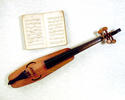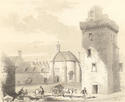Culture and Leisure
By Eila Williamson
 From the late 16th century evidence of Glasgow's culture and leisure becomes more plentiful and varied. Throughout the burgh records of this period, for example, there are references to Glasgow's musicians. A piper and drummer were responsible for sounding the curfew in the morning and at night. They also played on special occasions such as celebrations for monarchs' birthdays at which there were bonfires and bell ringing. There are references to music teachers (some of whose contracts made provision for the teaching of poor scholars), although the teaching of music was not continuous throughout the period. The later 17th century marked a diversification in the types of school available. In 1663 there was a teacher of French, dancing and fencing while in the 1690s there was a school for gentlewomen. By 1734 the most notable dance teacher was Daniel Barrell who built a school and ballroom in which to hold his classes and present shows.
From the late 16th century evidence of Glasgow's culture and leisure becomes more plentiful and varied. Throughout the burgh records of this period, for example, there are references to Glasgow's musicians. A piper and drummer were responsible for sounding the curfew in the morning and at night. They also played on special occasions such as celebrations for monarchs' birthdays at which there were bonfires and bell ringing. There are references to music teachers (some of whose contracts made provision for the teaching of poor scholars), although the teaching of music was not continuous throughout the period. The later 17th century marked a diversification in the types of school available. In 1663 there was a teacher of French, dancing and fencing while in the 1690s there was a school for gentlewomen. By 1734 the most notable dance teacher was Daniel Barrell who built a school and ballroom in which to hold his classes and present shows.
Theatre
 Street theatre was popular. There is reference to a play day in 1599 at which the citizens were required to attend under threat of fine. Aside from the king's day celebrations in the 17th century, there were visits by quack doctors who tried to sell various medicinal remedies by enticing potential customers with entertainments involving tight-rope walkers and acrobats. The most famous of these was Doctor John Pontus who visited Glasgow in 1643. A touring elephant was displayed to Glaswegians in 1681.
Street theatre was popular. There is reference to a play day in 1599 at which the citizens were required to attend under threat of fine. Aside from the king's day celebrations in the 17th century, there were visits by quack doctors who tried to sell various medicinal remedies by enticing potential customers with entertainments involving tight-rope walkers and acrobats. The most famous of these was Doctor John Pontus who visited Glasgow in 1643. A touring elephant was displayed to Glaswegians in 1681.
 Purpose-built theatres began to appear in the mid-18th century. A temporary booth theatre was erected against the wall of the Bishop's Castle in 1752 but was short-lived, being destroyed in 1754 by a mob inspired by the preacher George Whitefield. A more substantial theatre was opened in 1764 in Alston Street in Grahamston, just outside the city boundary, with the financial support of a group of five merchants that included James Dunlop of Garnkirk. Although the opening night was disrupted by arson, again involving religious zealots, this theatre survived until 1780.
Purpose-built theatres began to appear in the mid-18th century. A temporary booth theatre was erected against the wall of the Bishop's Castle in 1752 but was short-lived, being destroyed in 1754 by a mob inspired by the preacher George Whitefield. A more substantial theatre was opened in 1764 in Alston Street in Grahamston, just outside the city boundary, with the financial support of a group of five merchants that included James Dunlop of Garnkirk. Although the opening night was disrupted by arson, again involving religious zealots, this theatre survived until 1780.
Art
 Merchant sponsorship was also sought by the initiators of an enterprising scheme to create an art academy in Glasgow. The brothers Robert (1707-1776) and Andrew Foulis (1712-1775), who were printers to the University of Glasgow, set up an Academy of Fine Arts in 1753 which was based in the Old College buildings in the High Street. The Foulis brothers amassed a collection of Old Masters paintings on their travels on the continent and these were used to inspire and help to train the students in painting, engraving, sculpture and printing. One of the most successful students was David Allan (1744-1796). After a spell in Rome under the tutorship of the Glasgow graduate and history painter Gavin Hamilton (1723-1798) he worked as a portrait painter and then became a genre painter (depicting scenes from everyday life) and illustrator. Among the others were James Tassie (1735-1799), a medallionist; Robert Paul (1739-1770) and Charles Cordiner (1746-1794). The Foulis Academy was ahead of its time but it came to an end in 1775 due to lack of funding and the death of Andrew Foulis, and despite the enthusiastic encouragement of Francis Hutcheson, Professor of Moral Philosophy at the University of Glasgow, 1730-1746.
Merchant sponsorship was also sought by the initiators of an enterprising scheme to create an art academy in Glasgow. The brothers Robert (1707-1776) and Andrew Foulis (1712-1775), who were printers to the University of Glasgow, set up an Academy of Fine Arts in 1753 which was based in the Old College buildings in the High Street. The Foulis brothers amassed a collection of Old Masters paintings on their travels on the continent and these were used to inspire and help to train the students in painting, engraving, sculpture and printing. One of the most successful students was David Allan (1744-1796). After a spell in Rome under the tutorship of the Glasgow graduate and history painter Gavin Hamilton (1723-1798) he worked as a portrait painter and then became a genre painter (depicting scenes from everyday life) and illustrator. Among the others were James Tassie (1735-1799), a medallionist; Robert Paul (1739-1770) and Charles Cordiner (1746-1794). The Foulis Academy was ahead of its time but it came to an end in 1775 due to lack of funding and the death of Andrew Foulis, and despite the enthusiastic encouragement of Francis Hutcheson, Professor of Moral Philosophy at the University of Glasgow, 1730-1746.
 Other notable Glasgow art included the portraits of reigning monarchs which were purchased by the civic authorities after the Restoration and displayed in the council house. From 1750 a portrait of Archibald Campbell, 3rd Duke of Argyll was also hung there. In 1733 an equestrian statue of King William III (William of Orange) was erected at Glasgow Cross. A statue of Zachary Boyd (c 1585-1653), minister of the Barony Church and rector of the University, was commissioned in 1658 and was displayed in a niche above an archway in the library tower of the Old College buildings. The decorative ware made at the Delftfield Pottery near Broomielaw Quay, 1748-1823, included bowls, plates, cups and fireplace tiles.
Other notable Glasgow art included the portraits of reigning monarchs which were purchased by the civic authorities after the Restoration and displayed in the council house. From 1750 a portrait of Archibald Campbell, 3rd Duke of Argyll was also hung there. In 1733 an equestrian statue of King William III (William of Orange) was erected at Glasgow Cross. A statue of Zachary Boyd (c 1585-1653), minister of the Barony Church and rector of the University, was commissioned in 1658 and was displayed in a niche above an archway in the library tower of the Old College buildings. The decorative ware made at the Delftfield Pottery near Broomielaw Quay, 1748-1823, included bowls, plates, cups and fireplace tiles.
Sport and Games
 From the later 16th century onwards the records contain more references to sport and games, much of it supported by the town council. In the late 16th and early 17th centuries footballs were purchased for use at Fastern's E'en (Shrove Tuesday), a custom which is evidenced elsewhere in Scotland and England. Horse racing in Glasgow seems to follow the pattern in urban centres across Scotland. In 1606 the coveted prizes were a bell and saddle and by 1625 a cup was presented to the winner. In 1675 notice was given of a foot race which involved three circuits of Glasgow Green. Following a petition by Mungo Cochrane, the council agreed in 1695 that a bowling green should be built on waste-ground east of Candleriggs and north of Bell's Wynd. It was considered "necessary for the ornament of the town and good and conveniencie of the inhabitants therof, and of strangers that resort therto".
From the later 16th century onwards the records contain more references to sport and games, much of it supported by the town council. In the late 16th and early 17th centuries footballs were purchased for use at Fastern's E'en (Shrove Tuesday), a custom which is evidenced elsewhere in Scotland and England. Horse racing in Glasgow seems to follow the pattern in urban centres across Scotland. In 1606 the coveted prizes were a bell and saddle and by 1625 a cup was presented to the winner. In 1675 notice was given of a foot race which involved three circuits of Glasgow Green. Following a petition by Mungo Cochrane, the council agreed in 1695 that a bowling green should be built on waste-ground east of Candleriggs and north of Bell's Wynd. It was considered "necessary for the ornament of the town and good and conveniencie of the inhabitants therof, and of strangers that resort therto".
On other occasions sport and games appear in the records for disruptive reasons. In 1586 Glasgow's kirk session disapproved of the football and pennystane (quoiting) which was being played in the High kirkyard. In 1589 their complaints were directed against golf and shinty and in 1595 golf and alley bowls were forbidden on Sundays. The presence of billiard tables in the area beside the University was claimed to be having a detrimental effect on students' studies in 1679 and 1681.
Drinking
Drinking was of course a popular recreation in Glasgow. Glasgow's most famous tavern was the Saracen's Head Inn in the Gallowgate, established in the mid-18th century (for which a punch bowl was made by the Delftfield Pottery in the 1760s). More genteel activities included visits to the city's coffee houses around Glasgow Cross and leisurely strolls on Glasgow Green. The latter are made reference to in James Arbuckle's poem "Glotta", published in 1721, which also describes a game of golf there. For the wealthy and educated there were various clubs and societies such as the Hodge Podge Club and the Literary Society of Glasgow - the members of which were often attracted as much by the opportunities to drink and dine well as to engage in philosophical, literary or political debate.